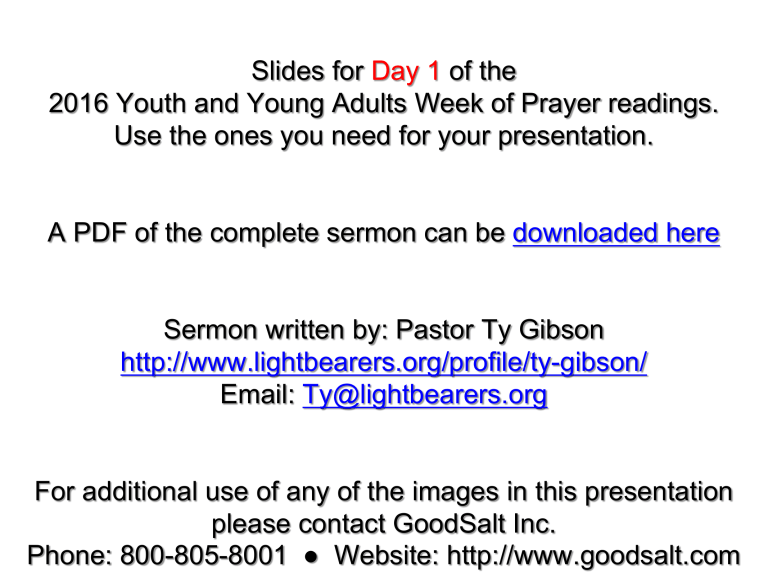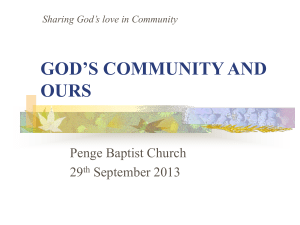
Slides for Day 1 of the 2016 Youth and Young Adults Week of Prayer readings. Use the ones you need for your presentation. A PDF of the complete sermon can be downloaded here Sermon written by: Pastor Ty Gibson http://www.lightbearers.org/profile/ty-gibson/ Email: Ty@lightbearers.org For additional use of any of the images in this presentation please contact GoodSalt Inc. Phone: 800-805-8001 ● Website: http://www.goodsalt.com Jesus – the Essence of Our Faith 2016 youth and young adults Week of Prayer Theme: Jesus—The Center of It All Copyright ©2015 General Conference of SDA Youth Ministries Department www.gcyouthministries.org In this Week of Prayer series we will be exploring EIGHT KEY Bible doctrines of the Seventh-day Adventist Church. The doctrinal truths of Scripture can be thought of as a series of perceptual windows through which God's character may be viewed from various different angles. For our purposes, let’s imagine the structure of truth as an octagonshaped building. On each of the eight sides of the structure, there is a window. Each window represents one of our doctrinal beliefs: • • • • • • • • DAY 1: The Trinity DAY 2: The Great Controversy DAY 3: The Law of God DAY 4: The Sabbath DAY 5: The Sanctuary DAY 6: Death and Hell DAY 7: The End Time DAY 8: The Second Coming Eight windows into one reality! Windows are designed for looking through, not at. A window serves its purpose when it operates as a visual passageway. No biblical doctrine is an end in itself: not the Sabbath, not the State of the dead, not the judgment, not end time prophecy. None of these truths exist to point to themselves. Rather, the Sabbath serves as a visual passageway into the heart of God. The sanctuary doctrine serves as a visual passageway into another dimension of God’s beauty and so on with every biblical doctrine. Think about it like this. As Seventh-day Adventists, we actually only have one belief, one doctrine: “God is love.” (1 John 4:16) That’s it. We don't believe many things, we believe one thing with many dimensions. The various doctrines we hold serve their purpose only to the degree that we communicate them in such a manner as to magnify the beauty of God’s love. In fact, Ellen White explicitly states that this is the case: It is the darkness of misapprehension of God that is enshrouding the world. Men are losing their knowledge of His character. It has been misunderstood and misinterpreted. At this time a message from God is to be proclaimed, a message illuminating in its influence and saving in its power. His character is to be made known. Into the darkness of the world is to be shed the light of His glory, the light of His goodness, mercy, and truth… The last rays of merciful light, the last message of mercy to be given to the world, is a revelation of His character of love. (Ellen White, Christ’s Object Lessons, p. 415). If correctly understood, our theological system has the potential to offer our world a beautiful and inviting picture of God unlike anything they have ever known before. Adventist theology, when viewed in Christ, is like a series of windows through which the character of God is clarified and exonerated. So let’s get started by looking through the first of our eight windows. Love cannot be experienced in isolation. Love, by definition, is other-centered rather than selfcentered; for it to really be love, it requires more than one person. With this we have realized something deep and vitally important for our understanding of God. Let’s unpack it. The first truth we encounter when we open the Bible is that God is a social unit rather than a solitary self. Notice the opening line of Scripture: “In the beginning God created the heavens and the earth.” (Genesis 1:1) The most obvious thing we see here is that there are two basic categories that compose reality: 1. God 3. And everything else God is the Creator and anything else that exists He created. This means that God predates and transcends all things that fall into the “made” category, and that God alone occupies the “unmade” category. The apostle John, in introducing Jesus, articulated this sublime insight with these words: “All things were made through Him, and without Him nothing was made that was made.” (John 1:3) Pretty deep, I know, but hang on because it's all about to become beautifully clear. In the same passage, John said this: “In the beginning was the Word, and the Word was with God, and the Word was God. He was in the beginning with God” (John 1:1, 2). In the beginning, who was with whom? “In the beginning… God… was with God.” In what sense were these equally divine persons “with” one another? John tells us in verse 18: “No one has seen God at any time. The only begotten Son, who is in the bosom of the Father, He has declared Him.” So interpersonal! John wants us to understand that Jesus, whom He earlier identified as none other than God, came to our world from a very specific and special relational place: from “the bosom of the Father”. Bosom is a poetic word that conjures up the idea of closeness; the Phillips translation says Jesus lives in the “closest intimacy with the Father”. Now, with all this in mind, go back to Genesis 1: “In the beginning God created the heavens and the earth.” The Hebrew word in this sentence that’s translated to English as “God” is a proper name in the original language. It is a super significant name, jampacked full of meaning. In fact, it is the most beautiful name that will ever leave your lips: Elohim. The thing that makes this name so meaningful is that it is a plural noun. In other words, the God that we encounter in the opening verse of the Bible is in some sense one and yet more than one. “Then God [Elohim] said, ‘Let Us make man in Our image, according to Our likeness’… So God created man in His own image; in the image of God He created him; male and female He created them.” Here we see that Elohim is composed of an “Us” and an “Our”. We are not to think of God as merely a “Me” and an “I”, but rather as social unit that involves more persons than a single solitary being. Remember our opening point: Love cannot be experienced in isolation. Now, in the context of this simple realization, we can read with understanding the most profound and powerful declaration in the Bible: “God is love.” (1 John 4:8) God has never existed in isolation. God is, and always has been, an “Us” and an “Our”—in other words, a social unit—because “God is love.” We could paraphrase the opening sentence of the Bible like this: “In the beginning LOVE created the heavens and the earth.” Cross reference this once again to John 1 and the picture becomes even more beautiful: “In the beginning was the Word, and the Word was with God, and the Word was God. He was in the beginning with God. All things were made through Him, and without Him nothing was made that was made” (John 1:1-3). Now go back to Genesis 1 for an additional brush stroke of the picture: “The earth was without form, and void; and darkness was on the face of the deep. And the Spirit of God was hovering over the face of the waters.” (Genesis 1:2) The Holy Spirit was also actively involved in the creation event, along with the Father and the Son. The God we encounter in Genesis 1, bearing the plural name Elohim, is composed of God the Father, God the Son, and God the Holy Spirit. Within the parameters of God’s own divine reality, apart from any created beings, God is an other-centered fellowship, a self-giving friendship. As we move forward from Genesis in the biblical narrative, we encounter what the Jewish people call, “the shema” which they regard to this day as the most important of all theological declarations: “Hear, O Israel: The Lord our God, the Lord is one!” (Deuteronomy 6:4). There is a hidden beauty here in plain sight, which is brought to light by asking the question: in what sense is the Lord our God one? We find the answer in Jesus, because He intentionally employed the language of the Shema to describe the relationship that exists between Himself and the Father: “I and My Father are one.”(John 10:30) Here’s the picture before us: • The Father is God, but not all there is of God. • Jesus Christ is God, but not all there is of God. • The Holy Spirit is God, but not all there is of God. All three, together, as an intimate social fellowship, compose one divine reality. This is why we use the word Trinity, or Tri-unity, to describe God. 1. It is not a dry doctrinal fact. 2. It is not a cold theoretical equation. 3. It is not a complex philosophical concept. The doctrine of the Trinity is a crystal clear window into God’s outgoing, other-centered, super-social character. Small group Discussion Time Have you heard the “truth” portrayed as a series of facts, as described at the beginning of this lesson? How did it make you feel? How did you react? Share together some of the concepts that have helped you to try to understand the Trinity. (Accept that it’s something humans cannot totally comprehend.) How would you describe or explain it to a Muslim or Jewish friend who thinks you are worshiping plural gods? What is it about the phrase “God is love” that most appeals to you? How has this foundational concept affected your life? Small group activity 2016 Youth and Young Adults Week of Prayer Sermons Copyright © 2015-2016 General Conference of Seventh-day Adventist® Youth Ministries Department Sermon written by: Pastor Ty Gibson http://www.lightbearers.org/profile/ty-gibson/ Email: Ty@lightbearers.org For additional use of any of the images in this presentation please contact GoodSalt Inc. Phone: 800-805-8001 ● Website: http://www.goodsalt.com





